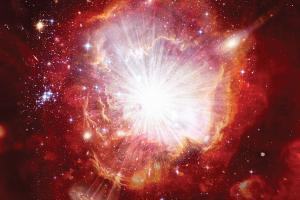We know that what we think of as ‘stuff’ in the universe is only a small part of it, right? The standard spiel is that ordinary stuff is 5% of the everything in the universe, dark matter about 25% and the rest – about 70% – is something called dark energy. Thereabouts. That’s on a “mass–energy equivalence basis” whatever that is.
Stuff, at least we can see it, although it goes very weird at the micro quantum physics level, where particles can be in two places at once, or in two different states at once, but if two particles are bonded, then change one and the other changes automatically and instantaneously even though kilometres apart in what Einstein called “spooky action at a distance”.
Dark matter, we can’t see, but we think it must be there to explain how galaxies work, because the ordinary gravity of stuff won’t do it.
Then a chap called Mordehai Milgrom hypothesised that dark matter was a dopey idea and replaced it with his modified Newtonian dynamics (MOND) concept. You see there is no consistency in dark matter, you have to calculate it separately for each galaxy, whereas all MOND does is tweak the basic laws of physics.
If Milgrom is right dark matter doesn’t exist, the effect can be explained by a feature of the laws of physics.
Then they found that the universe was expanding at an accelerating speed, when everyone expected it to be slowing down. So a new field permeating the universe was called into being and named “dark energy”. Amazingly, there is no speed limit, so galaxies could theoretically move away from each other faster than the speed of light. We are meant to think of it as space opening up between the galaxies rather than galaxies moving through space.
Problem is that the space is far from empty. Each bit of a vacuum is full of particles briefly blinking in and out of existence. The energy involved, called vacuum energy, is massive. Maggie McKee in the New Scientist tells us that every cupful of space has “the energy needed to accelerate the universe’s growth.”
Now the problem is:
Energy, like matter, causes space to curve, according to Einstein’s general theory of relativity. Calculations suggest that this vacuum energy is so strong that it would make the universe curve in on itself until it spans less than the distance from Earth to the moon – and clearly it’s bigger.
Enter Nemanja Kaloper of the University of California, Davis, and Antonio Padilla of the University of Nottingham. They found a way of modifying the equations of the theory of general relativity on the whole of space and time just enough to make sure that what we see happening happens.
For reasons unexplained, but I believe them, this makes the universe finite, which means that the expansion at some point will stop and the whole caboodle will contract.
That leaves them with just two problems to work on.
First, they need a theory which will show that their calculations are necessary rather than arbitrary. The elusive theory of everything? If it also explains “spooky action at a distance” that would be handy.
Second, they need to work out how soon the expansion stops. The thinking is not next week, rather a few tens of billions of years hence.
With an ever expanding universe and entropy the world doesn’t end, it just becomes cold and lonely. If Kaloper and Padilla are right it ends with a big crunch. And then perchance a new bang. That’s not in the article, I just made it up, but the accompanying image looks more like a bang than a crunch. The artist must have had the same idea.


There you go again Brian, depending on science heroes.
But seriously, thank you. What a fascinating read.
zoot, my pleasure. One of the small luxuries of my life is a subscription to the dead tree version on the New Scientist. We use it for toilet reading. There one can meditate on the meaning of the universe and everything!
The New Scientist ongoing tale on the meaning of life and everything is an endless source of entertainment.